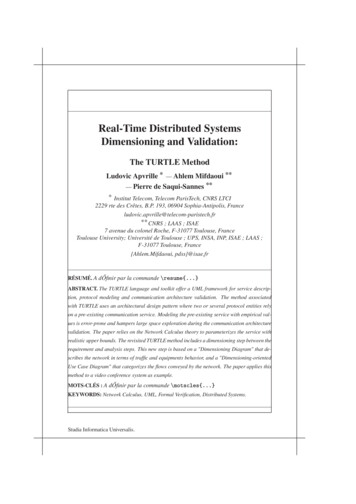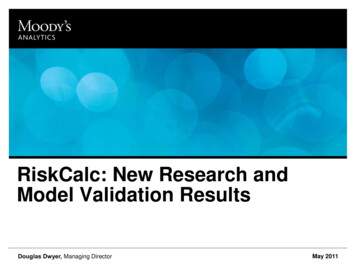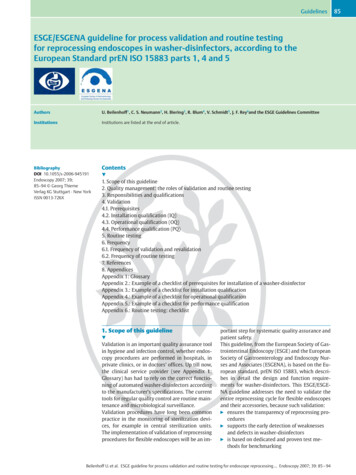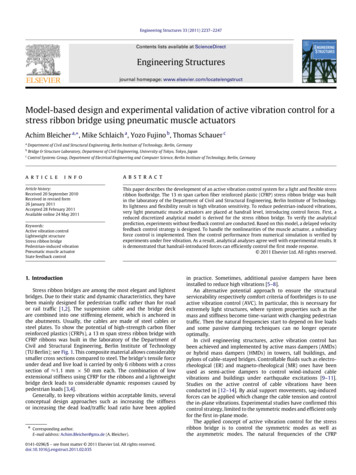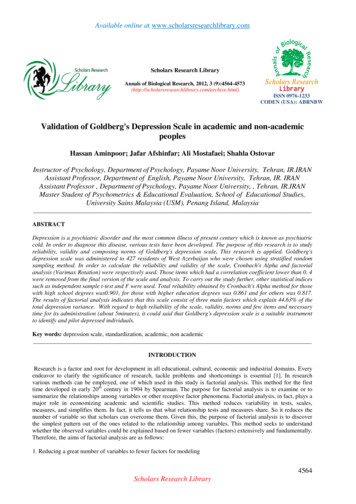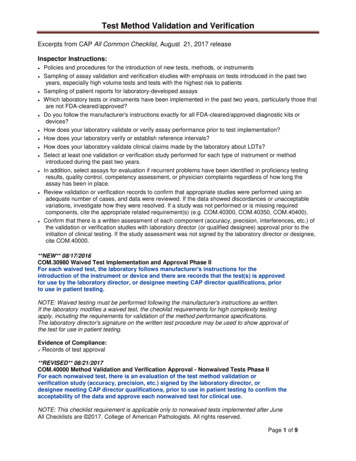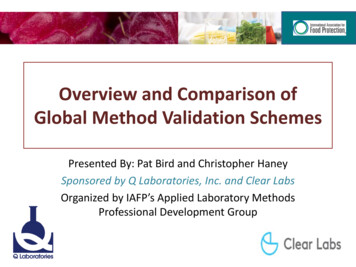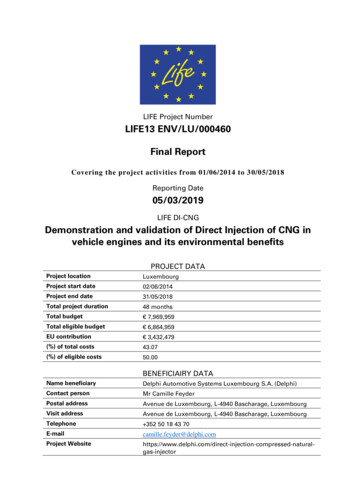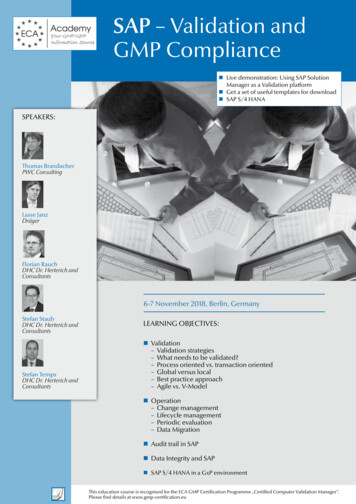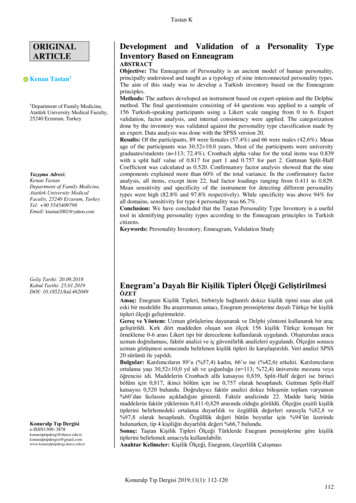
Transcription
Tastan KORIGINALARTICLEKenan Tastan11Departmentof Family Medicine,Atatürk University Medical Faculty,25240 Erzurum, TurkeyYazışma Adresi:Kenan TastanDepartment of Family Medicine,Atatürk University MedicalFaculty, 25240 Erzurum, TurkeyTel: 90 5545409798Email: ktastan2002@yahoo.comGeliş Tarihi: 20.09.2018Kabul Tarihi: 25.01.2019DOI: 10.18521/ktd.462049Konuralp Tıp i.duzce.edu.trDevelopment and Validation of a Personality TypeInventory Based on EnneagramABSTRACTObjective: The Enneagram of Personality is an ancient model of human personality,principally understood and taught as a typology of nine interconnected personality types.The aim of this study was to develop a Turkish inventory based on the Enneagramprinciples.Methods: The authors developed an instrument based on expert opinion and the Delphicmethod. The final questionnaire consisting of 44 questions was applied to a sample of156 Turkish-speaking participants using a Likert scale ranging from 0 to 6. Expertvalidation, factor analysis, and internal consistency were applied. The categorizationdone by the inventory was validated against the personality type classification made byan expert. Data analysis was done with the SPSS version 20.Results: Of the participants, 89 were females (57.4%) and 66 were males (42.6%). Meanage of the participants was 30.52 10.0 years. Most of the participants were universitygraduates/students (n 113; 72.4%). Cronbach alpha value for the total items was 0.839with a split half value of 0.817 for part 1 and 0.757 for part 2. Guttman Split-HalfCoefficient was calculated as 0.520. Confirmatory factor analysis showed that the ninecomponents explained more than 60% of the total variance. In the confirmatory factoranalysis, all items, except item 22, had factor loadings ranging from 0.411 to 0.829.Mean sensitivity and specificity of the instrument for detecting different personalitytypes were high (82.8% and 97.8% respectively). While specificity was above 94% forall domains, sensitivity for type 4 personality was 66.7%.Conclusion: We have concluded that the Taştan Personality Type Inventory is a usefultool in identifying personality types according to the Enneagram principles in Turkishcitizens.Keywords: Personality Inventory, Enneagram, Validation StudyEnegram’a Dayalı Bir Kişilik Tipleri Ölçeği GeliştirilmesiÖZETAmaç: Enegram Kişilik Tipleri, birbiriyle bağlantılı dokuz kişilik tipini esas alan çokeski bir modeldir. Bu araştırmanın amacı, Enegram prensiplerine dayalı Türkçe bir kişiliktipleri ölçeği geliştirmektir.Gereç ve Yöntem: Uzman görüşlerine dayanarak ve Delphi yöntemi kullanarak bir araçgeliştirildi. Kırk dört maddeden oluşan son ölçek 156 kişilik Türkçe konuşan birörnekleme 0-6 arası Likert tipi bir dereceleme kullanılarak uygulandı. Oluşturulan aracauzman doğrulaması, faktör analizi ve iç güvenilirlik analizleri uygulandı. Ölçeğin sonucuuzman görüşmesi sonucunda belirlenen kişilik tipleri ile karşılaştırıldı. Veri analizi SPSS20 sürümü ile yapıldı.Bulgular: Katılımcıların 89’u (%57,4) kadın, 66’sı ise (%42,6) erkekti. Katılımcılarınortalama yaşı 30,52 10,0 yıl idi ve çoğunluğu (n 113; %72,4) üniversite mezunu veyaöğrencisi idi. Maddelerin Cronbach alfa katsayısı 0,839, Split-Half değeri ise birincibölüm için 0,817, ikinci bölüm için ise 0,757 olarak hesaplandı. Guttman Split-Halfkatsayısı 0,520 bulundu. Doğrulayıcı faktör analizi dokuz bileşenin toplam varyansın%60’dan fazlasını açıkladığını gösterdi. Faktör analizinde 22. Madde hariç bütünmaddelerin faktör yüklerinin 0,411-0,829 arasında olduğu görüldü. Ölçeğin çeşitli kişiliktiplerini belirlemedeki ortalama duyarlılık ve özgüllük değerleri sırasıyla %82,8 ve%97,8 olarak hesaplandı. Özgüllük değeri bütün boyutlar için %94’ün üzerindebulunurken, tip 4 kişiliğin duyarlılık değeri %66,7 bulundu.Sonuç: Taştan Kişilik Tipleri Ölçeği Türklerde Enegram prensiplerine göre kişiliktiplerini belirlemek amacıyla kullanılabilir.Anahtar Kelimeler: Kişilik Ölçeği, Enegram, Geçerlilik ÇalışmasıKonuralp Tıp Dergisi 2019;11(1): 112-120112
Tastan KINTRODUCTIONThe Enneagram of Personality (or simply theEnneagram, from the Greek words ἐννέα [ennea,meaning "nine"] and γράμμα [gramma, meaningsomething "written" or "drawn") is a model ofhuman personality, which is principally understoodand taught as a typology of nine interconnectedpersonality types (1). One of the main problemswith the Enneagram is perhaps that where the originof enneagram is precisely based on. It is not knownby whom the enneagram was first time discoveredand from where it comes out. However, some cluesshow that the Enneagram has been taught orally inMuslim Sufi brotherhoods in the Middle East (2).The philosophy behind the Enneagram probablycontains components from mystical Judaism,Christianity, Islam, Taoism, Buddhism, and ancientGreek Philosophy; all traditions that stretch backinto antiquity. The Russian mystical teacher G.I.Gurdjieff introduced enneagram to Europe in the1920s (3). Gurdjieff’s teachings, which were passedon primarily by oral tradition in the circles ofinitiates, consist of a unique system for man'sunderstanding of the universe (4).The Enneagram, which is an important toolfor improving relationships with family, friends,and co-workers, is the study of the nine basic typesof people. It explains why we act like the way wedo, and it points to specific directions for individualgrowth. On the other hand, the number 9 hasparticular significance in the Turkish regions andIslamic culture from which Sufism derives (5).If we shortly express the personality types,we can say that there is a configuration consistingof nine personality types, each one demonstrated bya number. One of the primary rules of theEnneagram is that the personality types ic is that not all the features of apersonality type may be seen in a person becausethe personality types contain a wide range (healthyunhealthy-normal). Another essential rule about theEnneagram is that none of the personality types isbetter or worse than others. Each personality typecan be classified in itself as better and worse (4).Each personality type will take on somefundamental impulses to defend himself against theworries of existence. In general, the number one“the perfectionist” personality type believes in thecorrectness of moral values. Number two “thehelper” personality type believes his/herimportance, and number three “the achiever”personality type believes his/her perfectness. Whilethe number four “the romantic” personality typegives importance to own freedom, number five “theobserver” personality type believes in the power ofknowledge. For the number six “the loyalist”personality type, the trust provided by the people isimportant; for number seven “the adventurer”personality type, the materiality is important. Thepower is important for the number eight “thechallenger” personality type. For the ninepersonality type what truly counts is peace (6,7).Knowing the type of personality is asignificant advantage, both for the person and forthe people in contact with him/her. The person firstought to know oneself, should know what kind ofthings he/she likes or dislikes, and should be able tocope better with stressors that put stress on him/her.The person will be able to make professionalchoices according to his own features and takeprecautions to prevent psychological disorderswaiting for him. Knowing the type of person mayfacilitate communication and may lead to afavorable dialogue between people.The Enneagram education is fitted intoStanford MBA syllabus and applied in the courtplea training at the Harvard Law School. TheEnneagram is taught at the universities in the USA,mainly at the departments of psychology, medicine,arts, business, and education. Companies use theEnneagram methods in the personnel recruitment,sales, and marketing (7).Standardized psychometric tests of adultpersonality and psychopathology such as theMinnesota Multiphasic Personality Inventory arecommonly utilized by health professionals as partof the therapeutic assessment procedure. It is evendemonstrated that personality type may be anindependent predictor of quality of life in old age(8). Also, correlative relationships betweenpersonality, posture, and pain have beendemonstrated (9). However, despite the extensiveresearch on personality types concerningpsychiatric illnesses, there is limited literature onpersonality traits of healthy individuals.Aim: The purpose of this study was todevelop an inventory measuring personality typesbased on the Enneagram principles and test itsvalidity and reliability among a Turkish speakingcommunity.MATERIAL AND METHODSStudy design and setting: We carried out avalidation study using specially designed selfadministered questionnaires for a mixt group ofTurkish speaking population.Item generation: A panel of 15 experts wasgenerated to prepare a pool of questions. Thecollected questions were revised by the authors,including questions from a literature search. Usingthis method, we created a list of 123 items.Instrument validation: The initial panel of15 experts was contacted. Each expert assessed thesuitability of each question by scoring them on ascale from 1 to 5 (1: the item does not measurepersonality types at all, 5: the item excellentlymeasures personality types). Questions with a highlevel of consensus were selected and compacted ina single list. The final list of 123 questions wasrefined in four consecutive meetings, using aKonuralp Tıp Dergisi 2019;11(1): 112-120113
Tastan Kqualitative method with a focus group composed ofthe researchers and three external experts, anddecreased to 53 items.Face validity and item refinement weremade by interviews with a sample of 10 patientsthat showed differing arrangements in wording. Theprocess ended when all major wording problemswere detected and addressed. Participants could fillin the questionnaire in 10–15 minutes.Internal consistency and constructstructure: Sample administration of the 53questions was done to professionals in the hospitaland patients (n 60) applying to the family practicecenter. Internal consistency was determined usingCronbach’s alpha and a split half test. Test-retestreliability could not be conducted at this time. Nineother questions were removed after checking forinternal consistency.Sampling and application: The finalquestionnaire with 44 questions was applied to aconvenience sample of 156 consecutive patientscoming to the family practice on the universitycampus during March-April 2017. All applicants 18 years of age were invited to join the study. 156patients out of 215 invited (72.5%) accepted to join.Responses were collected using a Likert scaleranging from 0 (Strongly No) to 6 (Strongly Yes)(Appendix 1 and 2). Hence, the mean minimum andmaximum scores for each personality dimensionmay range from 0 to 6. The questionnaire was selfapplied in a convenient and silent room.The principal author interviewed allparticipants using a structured method lasting 60minutes. At the end of the interview, the authorclassified participants into one of the t validity was checked by comparingclassification by the questionnaire with the authors’rating. Study flow is shown in Figure 1.Analysis: The intraclasscorrelationcoefficient (ICC) with a two-way mixed model wasused to check for consistency or agreement ofvalues within cases. The reliability of the generalitems was calculated using Cronbach’s alpha,which was considered acceptable if the value was 0.8. Besides, a split half test was performed todetect any incongruence.The structure and subscales of theinstrument were analyzed using confirmatory factoranalysis followed by the varimax rotation. As theextraction method, fixed number of nine factorswas used. A minimum factor loading of 0.40 wasused as the criterion for each retained item. Oneitem not matching this rule was assigned to a factorwith the most theoretical sense. Scoring of the scalewas done by taking the mean values of the items ineach dimension. The dimension with the highestmean score was regarded as the main personalitytype. Data from socio-demographic variables werepresented as n (%) or mean standard deviation(SD). All analyses were conducted using the SPSSv20.0 software. Ethical approval of the study wasobtained from the Atatürk University MedicalFaculty local ethics committee (Date: 26.12.2013 #:11).Figure 1: Study flow diagram.RESULTSTotal 156 participants joined the final studywith a sex distribution of 89 females (57.4%) and66 males (42.6%). One participant did not disclosehis/her sex. Mean age of the participants was30.52 10.0 years. Participants were from differentoccupational groups, namely university students(n 74; 47.4%), state employees (n 56; 35.9%),private employees (n 14; 8.9%), and housewives(n 12; 7.7%). Educational status of the participantswas mainly university degree (n 113; 72.4%).Remaining 43 participants (27.6%) were highschool graduates.Cronbach alpha value for the total items was0,839 with a split half value of 0.817 for part 1 and0.757 for part 2. Guttman Split-Half Coefficientwas calculated as 0.520.Confirmatory factor analysis showed that thenine components explained more than 60% of thetotal variance (Table 1, Figure 2).Konuralp Tıp Dergisi 2019;11(1): 112-120114
6-Certainly yes5-Yes4-Partially yes2-Partially no3-Neither yes orno1-NoAppendix 1. Items of the Taştan Personality Types Instrument.Kenan Taştan Personality Types InstrumentThe following questions are designed to help defining yourpersonality type. Considering your general daily life, please markone box for each question with an (X).Age Sex:1-Female ( ) 2-Male ( )Occupation: Education: NoBecause I consider all possibilities, I have difficulty in getting into1action2I am sensitive to the details.3I have a cri
observer” personality type believes in the power of knowledge. For the number six “the loyalist” personality type, the trust provided by the people is important; for number seven “the adventurer” personality type, the materiality is important. The power is important for the number eight “the


